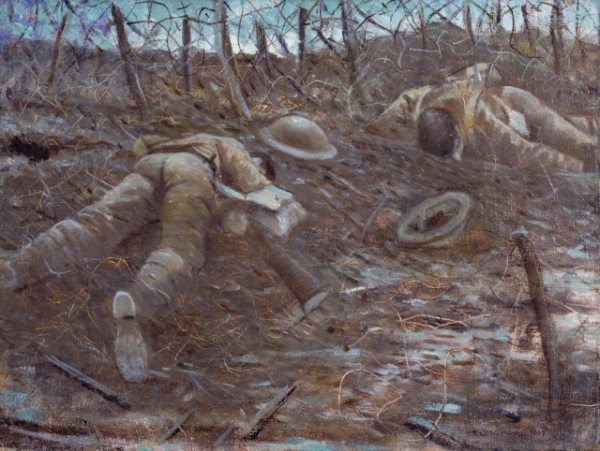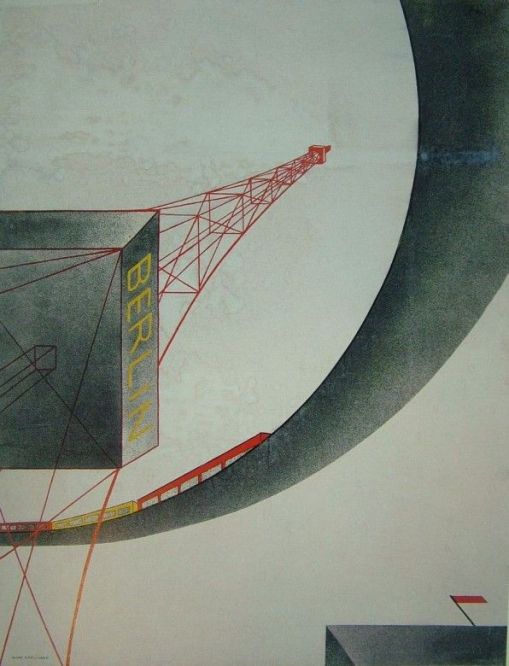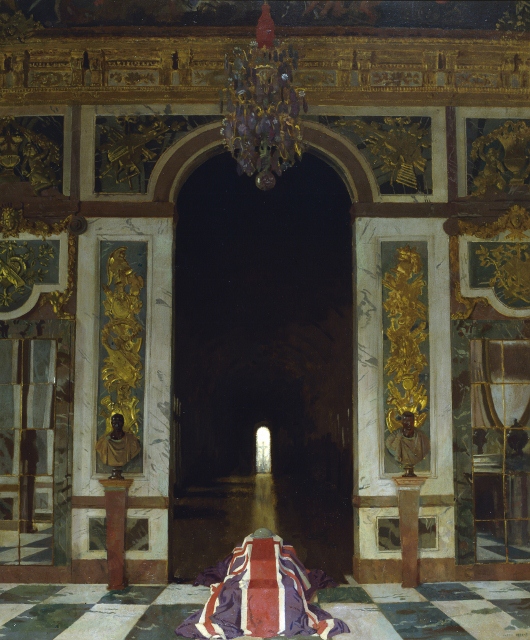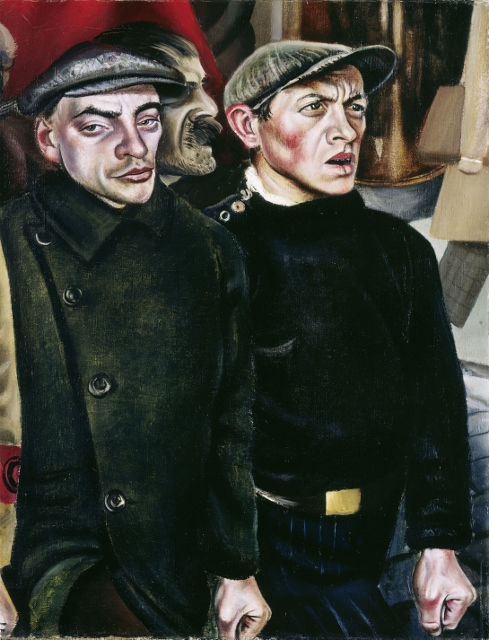The First World War ended on 11 November 1918. To mark the end of the conflict Tate Britain has been hosting an extensive exhibition devoted to the aftermath of the war as it affected the art of the three main nations of Western Europe – Britain, France and Germany.
Thus there is nothing by artists from, say, Russia, Italy, Austria-Hungary, Turkey, Serbia, Bulgaria, nor from the white colonies, Canada, Australia, New Zealand, nor from America which entered the war in 1917. It is a Western European show of Western European art.
Masterpieces
The show includes a staggering number of masterpieces from the era, interspersed with fascinating works by much less-well-known artists.
For example, room one contains the Rock Drill by Jacob Epstein, possibly my favourite work of art anywhere, by anyone. For me this hard brooding metallic figure contains the secret of the 20th century, and of our technological age.

Torso in Metal from The Rock Drill (1913 to 1914) by Jacob Epstein. Tate © The Estate of Jacob Epstein
Layout
The exhibition is in eight rooms which take you in broad chronological order:
- Images of battlefields and ruins, early movies, and memorabilia (helmets, medals, cigarette cases)
- The official War memorials of the three featured nations (statues, designs and paintings by conventional artists such as William Orpen and the sculptor Charles Sargeant Jagger)
- A room devoted to images of disfigured and maimed soldiers
- Dada and Surrealism i.e. the extreme irrationalist response to the war of Swiss, German and French artists – including signature works by George Grosz, Max Ernst, Kurt Schwitters
- A room of black and white prints showcasing series of lithographs and woodcuts made by Max Beckman, Käthe Kollwitz, Otto Dix and Georges Rouault
- The ‘return to order’ in a revival of nostalgic landscapes in works by Paul Nash and George Clausen, sculptures of sleek femininity by Eric Gill and Aristide Maillol, neo-classical portraiture by Meredith Frampton, and the revival of a strange post-war type of Christian faith in the work of Stanley Spencer and Winifred Knights
- Politics and pass-times – divided between gritty depictions of a newly politicised working class by socialist and communist artists, such as The International by Otto Griebel, and a rare opportunity to see an original ‘portfolio’ or pamphlet of lithographs by George Grosz – and on the other hand, depictions of the newly fashionable night-life, the craze for jazz dancing depicted in The Dance Club 1923 by William Patrick Roberts, cabaret clubs of the Weimar Republic, or the Folies Bergère as painted by English artist, Edward Burra
- The exhibition ends with brave new world visions of technology, machinery, skyscrapers, Russian constructivist images by El Lissitsky, the geometric paintings of Fernand Leger, and the sleek new design and architecture of the German Bauhaus school
1. Images of the battlefield
First impressionistic indications of the appalling nature of the war. A display case contains an original infantry helmet from each of the three featured nations, one French, one German and one British. Oil paintings of corpses in trenches or hanging on barbed wire. A rare black-and-white-film shot from an airship shows the devastation
2. Memorials
In terms of memorials I don’t think you can do better than Edwin Lutyens’s Cenotaph in Whitehall, arresting in its monolithic abstraction. But the show includes three large memorial sculptures by Charles Sergeant Jagger.
3. The disfigured
The room of disfigured servicemen is hard to stay in. The grotesques of Otto Dix and Gorge Grosz are bearable because they have a cartoon savagery and exaggeration which defuses the horror. But the realistic depictions of men with their jaws shot away, half their faces missing, skin folding over where their eyes should be, and so on by artists like Heinrich Hoerle and Conrad Felixmuller, are almost impossible to look at.

Prostitute and Disabled War Veteran, Two Victims of Capitalism by Otto Dix (1923) © Estate of Otto Dix
4. Dada and Surrealism
The exhibition takes on a completely different tone when you enter the room of works by Dada and Surrealist artists – although the grotesques of the previous room make you realise how so much of Dada’s strategy of cutting up and collage, of rearranging anodyne images (especially from glossy optimistic magazines and adverts), to create incongruous and grotesque new images, is actually a very reasonable response to the grotesqueness of war and its dismemberments.
Here there are works by Kurt Schwitters, pioneer of cut up and paste art, as well as the stunning painting Celebes by early Surrealist Max Ernst.
Seeing a number of examples of post-war collage – works by Max Ernst, Kurt Schwitters, the English Surrealist Edward Burra and their peers like Hannah Hoch and Rudolf Schlichter all together – brings out the superiority of George Grosz.
It’s probably because I’m a longstanding fan but he seems to me to combine the best eye for design and caricature, with the best feel for how to create a collage of elements cut out from newspapers and magazines.
As well as a good selection of his biting political satires, there is an opportunity to see a reconstruction of the Dada-mannequin he created for the 1920 Berlin Dada exhibition.
Why be sensible? How could you be sensible and take any of the standards and values of the old order seriously? After what they had seen in the trenches? After that old order had brought about Armageddon?
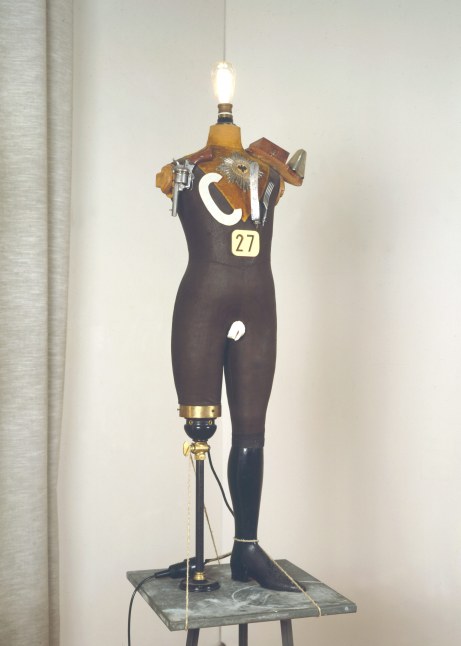
The Petit-Bourgeois Philistine Heartfield Gone Wild. Electro-Mechanical Tatlin Sculpture (1920) by George Grosz © Estate of George Grosz, Princeton, N.J.
5. Prints, lithographs, woodcuts
In the print portfolio room it is interesting to compare the style of the four featured artists: Max Beckman was too scratchy and scrappy and cluttered for my taste. The Georges Rouault images are harsh but use shading to create an eerie, gloomy depth, as if done with charcoal.

‘Arise, you dead!’ (War, plate 54) (1922 to 1927) by Georges Rouault. Fondation Georges Rouault © ADAGCP, Paris and DACS, London
By contrast Käthe Kollwitz’s series War is made from harsh, stark, pagan woodcuts, which exude a really primeval force. This set is a masterpiece. You can see the continuity from the harsh emotional extremism of pre-war German Expressionism, but here a widely used technique has found its perfect subject. Kollwitz is a great artist. Her images may be the most profound in the show.
6. The return to order
After the physical and metaphysical gloom of the print room, room six is large, well lit and full of images of sweetness and delight. In all kinds of ways the European art world experience a post-war ‘return to order’, a revival of neo-classical technique, in music as much as in painting. It had quite a few distinct strands.
Landscape
One strand was a return to painting idyllic landscapes, represented here by a haycart trundling down a lane by the pre-war artist George Clausen, and a similarly idyllic but more modern treatments of landscape by the brothers Paul and John Nash.
Woman
After the disfigurements of the war and the parade of grotesques in the previous galleries, this one contains a number of images of complete, undisfigured bodies, particularly female bodies, used as celebrations of beauty, fertility, of life. These include the big, primeval statue Humanity by Eric Gill, alongside a more realistic depiction of a naked woman, Venus with a Necklace by Aristide Maillol. After such horror, why not? Why not unashamed celebrations of peace, whole-bodiedness, beauty, youth, fertility – a new hope?
Interestingly, this room contains three or four works by Picasso, portraits of women or a family on a beach, done in a kind of revival of his rose period, with the figures now more full and rounded.
Neue Sachlichkeit
Another strand was the particularly German style known as ‘New Objectivity’ which I’ve written about extensively elsewhere, not least because it was itself sub-divided into a number of strands and styles.
- The New Objectivity: Modern German Art in the Weimar Republic 1918 to 1933 edited by Stephanie Barron and Sabine Eckmann (2015)
- The New Objectivity
It’s represented here by a signature work from the era, Christian Schad’s half-realistic, half-cartoonish, and wholly haunting self-portrait of 1927.

Self-Portrait (1927) by Christian Schad © Christian Schad Stiftung Aschaffenburg/VG Bild-Kunst, Bonn and DACS, London
Christianity
Amazingly, after such a cataclysmic disaster, many artists retained their Christian faith, although it emerged in sometimes strange and eccentric new visions.
These are exemplified by the English artists Stanley Spencer, who is represented by one of the many paintings he made setting Christian stories in his native home town of Cookham. And also by the strange and eerie vision of Winifred Knights, here represented by her unsettling vision of the Flood.
Not so long ago I saw a whole load of Knights’ paintings at a retrospective at Dulwich Picture Gallery. Seeing it here makes you realise the link to the stark geometric modernism of someone like Paul Nash. But also to the deliberately naive style of Spencer. It is a kind of Christianity by floodlights.
Portraiture
Separate from these varieties of self-conscious modernism was an entire strand of neo-classical portraiture. A style which had observed and absorbed the entire Modernist revolution from Cezanne onwards, and then reverted to painting exquisitely demure neo-classical portraits, generally of demure and self-contained young women. Exemplified here by Meredith Frampton’s still, posed portrait of Margaret Kelsey.
Is this a portrait of refinement and sensibility? Or is there an eerie absence in it, a sense of vacuum? Does it have all the careful self-control of someone recovering from a nervous breakdown?
7. Politics and pastimes
Room seven juxtaposes images of The People, The International and the proletariat – with images of jazz bands and people getting drunk in nightclubs. Which is the real world? The International by the German communist painter Otto Griebel faces off against William Roberts modernist depiction of a jazz nightclub (heavily influenced, I’d have thought, by Wyndham Lewis’s pre-war Vorticism).

The Dance Club (1923) by William Roberts. Leeds Museums and Galleries © Estate of John David Roberts
By now it felt as if the exhibition was turning into an overview of artistic trends of the 1920s. A number of the works were painted 10 or 12 years after the end of the war. When does an aftermath stop being an aftermath?
8. Brave new worlds
The last room is devoted to technocratic visions of the machine age. Russian constructivists, French futurists, some of the old Vorticists, all the Bauhaus artists, looked to a future of skyscrapers, chucking out Victorian ideas of design and taste and creating a new, fully twentieth century art, architecture and design.
Fernand Leger perfected a post-cubist style based on brightly coloured geometric shapes suggesting a new machine civilisation, and the exhibition includes footage from the experimental film he made, Ballet Mechanique with music by the fashionably machine-age composer George Antheil. The Russian constructivist El Lissitsky devised an entirely new visual language based on lines and fractured circles. Bauhaus teacher Oskar Schlemmer is represented by an abstract figurine. Oskar Nerlinger evolved from pencil sketches of the war to developing a distinctive style of constructivist illustration featuring stylised views of up to the minute architecture.
Now I like this kind of thing very much indeed but I feel we had wandered quite a long way from the First World War. Much of this last room struck me as having next to nothing to do with the war, or any war, instead being the confident new visual language of the hyper-modern 20s and 30s.
Wandering back through the rooms I realised the exhibition splits into two parts: rooms one to five are unambiguously about war, the horrors of war, trenches and barbed wire and corpses, moving onto war memorials and horrible images of mutilated soldiers, how those disfigurements were taken up into the distortions and fantasies of Dada and Surrealism and then extracted into a kind of quintessence of bleakness in the woodcuts of Kollwitz.
And then part two of the show, rooms 6, 7 and 8 show the extraordinary diversity of forms and style and approaches of post-war art, from nostalgic or semi-modernist landscape, through neo-classical if unnerving portraiture, Christianity by floodlight, from bitterly angry socialist realism to the frivolities of jazz bands and strip clubs, and then onto the Bauhaus and Constructivist embrace of new technologies (radio, fast cars, cruise liners) and new design and photographic languages.
Whether these latter rooms and their contents can be strictly speaking described as the ‘aftermath’ of the Great War is something you can happily spend the rest of the day debating with friends and family.
But there is no doubting that the exhibition brings together a ravishing selection of masterpieces, well-known and less well-known, to create a fascinating overview of the art of the Great War, of the immediate post-war period, and then the explosion of diverse visual styles which took place in the 1920s.
From the po-faced solemnity of:
to the compelling crankiness of:

‘Daum’ Marries her Pedantic Automaton ‘George’ in May 1920, John Heartfield is Very Glad of It (1920) by George Grosz © Estate of George Grosz, Princeton, N.J.
From the earnest political commitment of:
to the vision of an all-metal brave new technocratic future:
The promotional video
Related links
- Aftermath continues at Tate Britain until 24 September 2018
- Complete text of the exhibiton wall labels (without illustrations)
Other blog posts about the Great War and its aftermath
Politics and soldiers
- The Vanquished: Why the First World War Failed to End 1917 to 1923 by Robert Gerwarth (2016)
- Bloodlands: Europe between Hitler and Stalin by Timothy Snyder (2010)
- Warsaw 1920 by Adam Zamoyski (2008)
- Forgotten Victory: the First World War Myths and Realities by Gary Sheffield (2001)
- The Great War (BBC TV series)
- Elgar’s Great War music
- Complete Memoirs of George Sherston by Siegfried Sassoon (1936)
- The Middle Parts of Fortune: Somme And Ancre, 1916 by Frederic Manning (1929)
- Goodbye to All That by Robert Graves (1929)
- Red Cavalry by Isaac Babel (1926)
- In Our Time by Ernest Hemingway (1925)
- Under Fire by Henri Barbusse (1917)
Art and design
- The Great War in Portraits @ National Portrait Gallery
- Frank Brangwyn and the First World War @ William Morris Gallery
- Winifred Knights @ Dulwich Picture Gallery
- The New Objectivity: Modern German Art in the Weimar Republic 1918 to 1933 edited by Stephanie Barron and Sabine Eckmann (2015)
- The New Objectivity
- George Grosz: The Berlin Years by Ralph Jentsch (1997)
- From Weimar to Wall Street 1918 to 1929 (1993)
- Art Deco by Alastair Duncan (1988)
- Bauhaus by Frank Whitford (1984)
- The Weimar Years: A Culture Cut Short by John Willett (1984)
- The New Sobriety: Art and Politics in the Weimar Period 1917 to 1933 by John Willett (1978)
- Weimar: A Cultural History 1918 to 1933 by Walter Laqueur (1974)
- Weimar Culture by Peter Gay (1968)
- A Small Yes and a Big No by George Grosz (1946)

